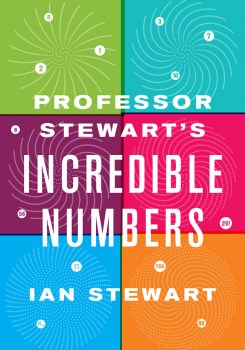The Mystique of Pi
An excerpt from “Professor Stewart’s Incredible Numbers.”
The following is an excerpt from Professor Stewart’s Incredible Numbers, by Ian Stewart.
The numbers we use for counting quickly become familiar, but some numbers are far stranger. The first really unusual number that we come across when learning mathematics is π. This number arises in many areas of mathematics, not all of which have any overt connection with circles. Mathematicians have calculated π to more than 12 trillion decimal digits. How do they do that? Understanding what kind of number π is resolves the ancient question: Can you square the circle with ruler and compass?
Ratio of the Circumference of a Circle to Its Diameter
We first encounter π when calculating the circumference and area of a circle. If the radius is r then the circumference is 2πr and the area is πr2. Geometrically, these two quantities are not directly related, so it’s actually rather remarkable that the same number π occurs in both. There’s an intuitive way to see why this happens. Cut a circle into lots of slices, like a pizza, and rearrange them to form an approximate rectangle. The width of this rectangle is approximately half the circumference of the circle, which is πr. Its height is approximately r. So its area is approximately πr x r = πr2.
That’s just an approximation, though. Maybe the numbers that come up in connection with the circumference and the area are very similar, but not identical. However, this seems unlikely, because the argument works however thin we make the slices. If we use a huge number of very thin pieces, the approximation becomes extremely accurate. In fact, by allowing the number of pieces to become as large as we wish, the difference between the actual shape and a genuine rectangle becomes as small as we wish. Using the mathematics of limits, this observation provides a proof that the formula for the area is correct and exact. That’s why the same number occurs for both the circumference and the area of a circle.
The limit procedure also defines what we mean by area in this context. “Areas of” are not as straightforward as we imagine. Areas of polygons can be defined by cutting them into triangles, but shapes with curved edges can’t be split up in that manner. Even the area of a rectangle is not straightforward if its sides are incommensurable. The problem is not stating what the area is: Just multiply the two sides. The hard part is to prove that the result behaves in the way that an area should—for example, that when you join shapes together their areas add up. School mathematics slides quickly past these problems and hopes no one notices.

Why do mathematicians use an obscure symbol to stand for a number? Why not just write the number down? At school we are often told that π = 22/7, but careful teachers will explain that this is only approximate [see 22/7]. So why don’t we use an exact fraction for π instead?
There isn’t one.
The number π is the best known example of an irrational number. Like the square root of 2, it can’t be represented exactly by any fraction, however complicated. It’s seriously difficult to prove this, but mathematicians know how to do it, and it’s true. So we definitely need a new symbol, because this particular number can’t be written down exactly using the usual number symbols. Since π is one of the most important numbers in the whole of mathematics, we need an unambiguous way to refer to it. It is the Greek ‘p’, the first letter in ‘perimeter’.
It’s really a rather cruel trick that the universe has played on us: a vitally important number that we can’t write down, except by using complicated formulas. This is a nuisance, perhaps, but it’s fascinating. It adds to π’s mystique.
Excerpted with permission from Professor Stewart’s Incredible Numbers, by Ian Stewart. Available from Basic Books, a member of The Perseus Books Group. Copyright © 2015.
Ian Stewart is author of Professor Stewart’s Incredible Numbers (Basic Books, 2015) and Professor Stewart’s Casebook of Mathematical Mysteries (Basic Books, 2014) and emeritus professor of mathematics at University of Warwick in Warwick, England.